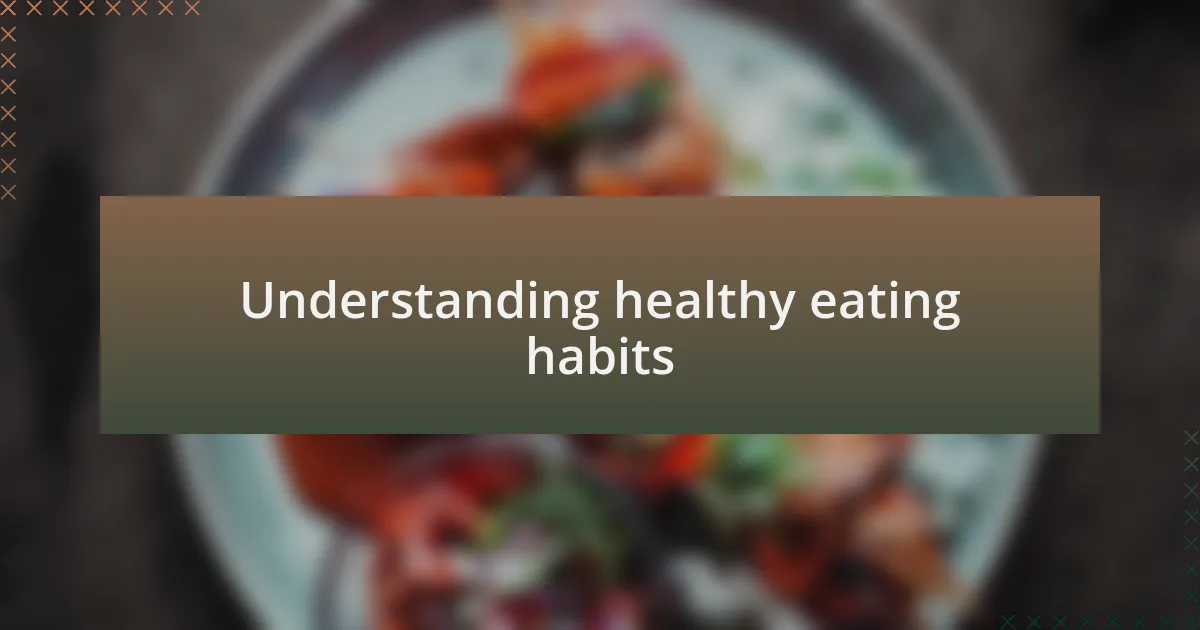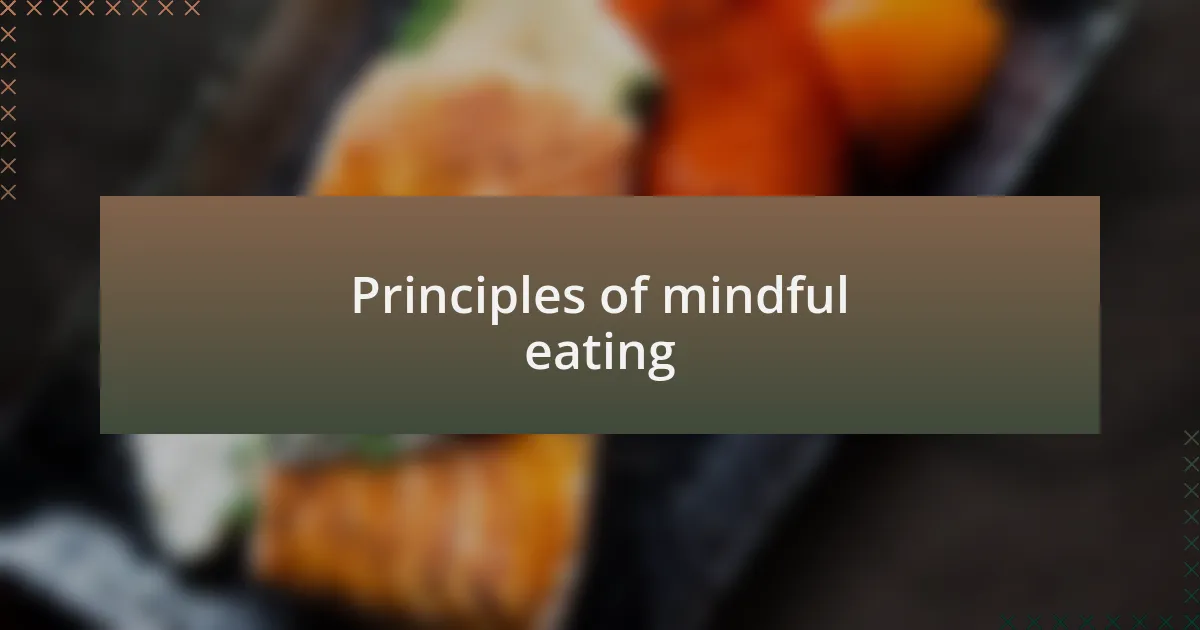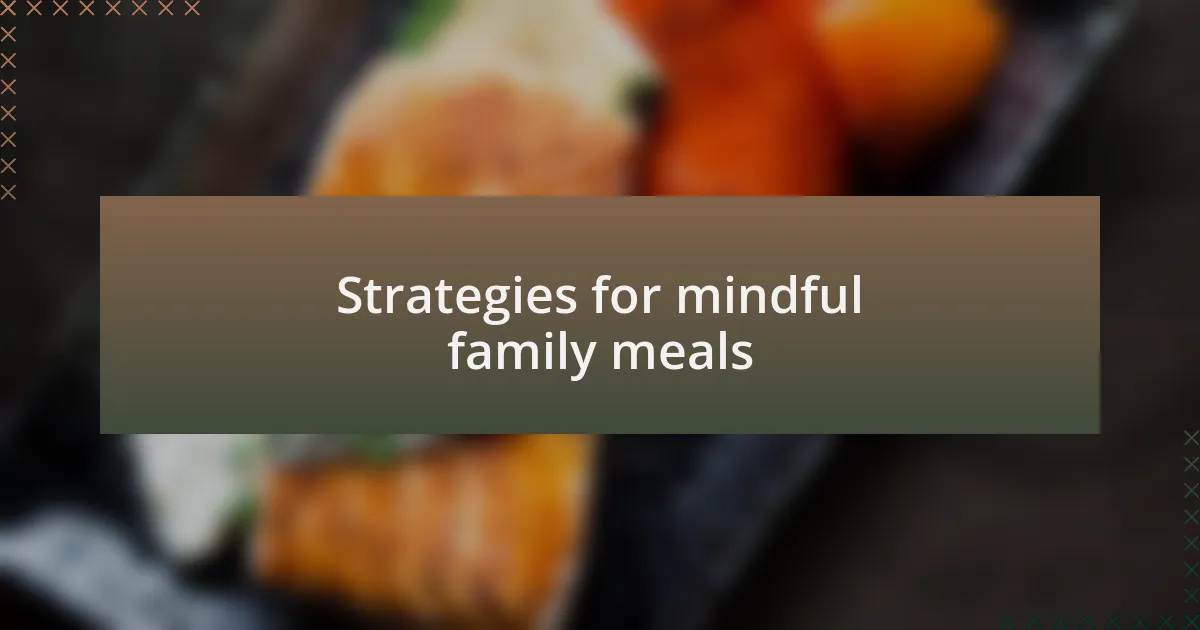Key takeaways:
- Healthy eating habits encompass not just food choices but also mindfulness, portion control, and family engagement.
- Mindful eating improves appreciation for meals, helps recognize hunger cues, and reduces unhealthy cravings.
- Involving the whole family in meal preparation and planning fosters a deeper connection to food and encourages trying new dishes.
- Creating a distraction-free environment enhances family bonding and elevates mealtime experiences.

Understanding healthy eating habits
Healthy eating habits aren’t just about choosing the right foods; they also involve understanding how those choices impact our bodies and minds. When I first started paying attention to my eating habits, I realized that not only did I feel better physically, but I also felt emotionally more balanced. Have you ever noticed how a balanced meal can change your mood for the better?
One aspect that really stood out to me was the importance of portion control. I used to pile my plate high, thinking it was a sign of abundance. However, learning to serve smaller portions helped me savor my food more and reduced the feeling of guilt that sometimes creeped in after a meal. Have you tried this approach? It’s incredible how much more I appreciate each bite when I’m not overwhelmed by the quantity on my plate.
Mindful eating is another crucial component that I’ve embraced. I recall a family dinner where we turned off the TV and put our phones away. Focusing solely on the meal and each other led to deeper conversations and a greater appreciation for the flavors on our plates. Can you remember a time when you felt completely present while eating? These moments transformed our meals from simple routines into cherished family bonding experiences.

The benefits of mindful eating
When I began the practice of mindful eating, I noticed a significant shift in my relationship with food. By truly focusing on each bite, I not only enjoyed the flavors more but also recognized when I was actually full. It’s astonishing how often we eat out of habit rather than hunger, isn’t it?
I’ve found that mindful eating has transformed our family meals. One dinner, I tried encouraging everyone to express what they loved about the meal while we ate. This simple act heightened our appreciation for each dish and made mealtime feel more like an experience than just a routine. I could see the joy in my kids’ eyes, and it reminded me of the importance of connection during meals.
Moreover, I’ve noticed that being present while eating significantly reduced my cravings for unhealthy snacks. Reflecting on those moments of awareness has made me realize that many cravings stem from emotional triggers rather than physical hunger. This understanding has empowered me to choose healthier options, creating a positive cycle in our eating habits. What about you? Have you experienced a similar realization?

Principles of mindful eating
Focusing on the present moment while eating is a fundamental principle of mindful eating. I remember a particularly hectic lunch when my partner and I decided to silence our phones and take a breather before we dug into our sandwiches. The flavors and textures really stood out that day, and I couldn’t help but savor each bite. Isn’t it interesting how pausing can enhance our experience?
Another core principle involves recognizing our hunger and fullness cues. On a recent family outing, I monitored how my kids responded to their meals. I made it a point to ask them if they were hungry or full halfway through their plates. This simple practice not only sparked conversations but also helped them learn to listen to their bodies, drawing them closer to mindful eating habits. Hasn’t it been enlightening to see kids develop a healthy relationship with food from a young age?
Lastly, creating a non-distracted environment plays a significant role in mindful eating. I have found that setting our dining table without screens truly changes the atmosphere. When my family sits down together, I notice how much more we engage with one another and the food. Wouldn’t you agree that connecting with your loved ones while enjoying a meal enhances both the food and the shared experience?

Incorporating healthy eating at home
When it comes to incorporating healthy eating at home, I’ve found that involving the whole family in meal preparation can make a significant difference. One weekend, I invited my kids to help chop vegetables for a stir-fry. Their excitement as they mixed the colors was infectious, and it sparked a genuine conversation about where each ingredient came from. Isn’t it fascinating how hands-on involvement fosters a deeper connection to what we eat?
I also like to make meal planning a family affair. Every Sunday, we gather to choose recipes for the week, encouraging everyone to bring their favorite healthy dishes to the table. This not only teaches my kids about nutrition but also gives them a sense of ownership over what we eat. Have you noticed how children are more willing to try new things when they’ve had a say in the decision-making process?
Lastly, I’ve made it a tradition to set aside one evening each week for a special family dinner featuring a nutritious theme. Recently, we focused on Mediterranean cuisine, trying new grains and legumes while discussing their health benefits. The joy on my children’s faces as they experimented with different tastes was truly heartwarming. Wouldn’t it be great if every meal could be an adventure in exploring new cultures and flavors together?

Creating a family meal plan
Creating a family meal plan is one of my favorite rituals. I remember one evening when we huddled around the kitchen table with our favorite cookbooks and a stack of sticky notes. Each family member picked a recipe that sparked their interest. Watching my youngest daughter light up as she suggested a chickpea curry reminded me how meal planning can ignite creativity and enthusiasm around healthy eating. Isn’t it amazing how everyone can become a part of the process?
As we finalize our weekly meal plan, I always encourage discussions about nutritional value, which often leads to fun debates over the merits of quinoa versus rice. It’s not just about filling our plates; it’s about understanding why we choose certain foods. One weekend, we discovered how easy it is to add leafy greens to almost any dish, and my son couldn’t believe how much tastier his smoothies became with just a handful of spinach added. Doesn’t this show that learning happens naturally when we engage as a family?
I’ve found that to make our meal plan successful, we also incorporate a mix of familiar and new recipes. Once, we tried a dish from a cuisine we’d never explored before—Thai cuisine—and it became an instant favorite. This blend keeps the excitement alive in our meals while encouraging everyone to broaden their palates. Have you noticed how trying new foods together can become a joyful adventure rather than a chore?

Strategies for mindful family meals
Emphasizing the importance of sitting together at the dining table transformed our mealtime experience. I vividly recall a night when we unplugged all devices, and it felt like a breath of fresh air. The conversation flowed effortlessly, and my teenage son began sharing stories from school that I had never heard before. Have you ever noticed how much richer family bonding becomes when distractions are put aside?
Creating an engaging atmosphere can make meals more enjoyable and mindful. We sometimes light a candle, play soft music, or even have themed dinners, which sparks lively discussions. I’ll never forget the week we decided to “travel the world” through our meals. Each dinner, we’d explore a different culture’s cuisine, making it a fun learning experience for us all. Doesn’t it feel rewarding to learn more about each other while appreciating the food we share?
I encourage my family to savor their food by practicing gratitude. Before each meal, we take a moment to express thanks for the deliciousness on our plates and the company around us. One evening, my daughter spoke about what she loved most—her favorite pasta dish—and seeing her appreciation for the meal deepened our connection. The act of gratitude opened a window to recognize the effort behind our meals. How often do we pause to appreciate the journey of our food, from the kitchen to the table?